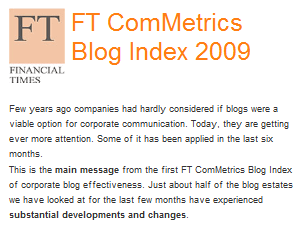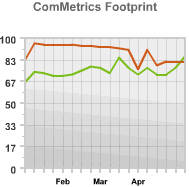 How do you rank compared to your competitors? This question is answered in part by the FT ComMetrics Blog Index, which ranks FT Global 500 and Fortune 500 firms’ corporate blogs. It will appear in the Financial Times newspaper’s regular supplement on Digital Business as well as on its webpage on Thursday, May 14.
How do you rank compared to your competitors? This question is answered in part by the FT ComMetrics Blog Index, which ranks FT Global 500 and Fortune 500 firms’ corporate blogs. It will appear in the Financial Times newspaper’s regular supplement on Digital Business as well as on its webpage on Thursday, May 14.
In the never-ending quest to get the biggest bag for your buck and move up the rankings to become part of the best-in-class, there are some mistakes that must be avoided at all costs.
The Good
We discovered the good while developing the FT ComMetrics Blog Index, meaning that corporate blogs are improving rapidly and many positive changes have occurred within the last few months. Most companies have done a lot of exciting work on improving their blogs, fostering communication and targeting their primary audience effectively.
The Bad
Building a large footprint remains a challenge. But most surprising is when companies make it very difficult for potential readers to find a blog. For example, finding anything about their blog on the Volvo bus webpage is difficult. If you’re lucky, you might come across a special page that shows a link to the blog. This seems a bit unnecessary.
On top of all this, the blog’s URL is complicated and has nothing to do with the corporate domain. This affects various statistical indicators that depend on the URL used, such as using the most obvious link results in these search results from Yahoo InLinks. Using a slightly different link shows more Yahoo! InLinks and so forth. No obvious links to a corporate blog can also affect its rankings in the search results as shown here.
The findings show that a simple, straight-forward link to reach the blog’s main page, such as blog.company.com, is a wise strategy.
The Ugly
 A most unfortunate situation is when, for no apparent reason, a blog shifts its home on the Internet. One example is the Toyota Open Road Blog, whose new home is now on the Toyota website. Unfortunately, this meant its URL changed (see old blog posts in the Internet archive), making it harder to find for those using old directions.
A most unfortunate situation is when, for no apparent reason, a blog shifts its home on the Internet. One example is the Toyota Open Road Blog, whose new home is now on the Toyota website. Unfortunately, this meant its URL changed (see old blog posts in the Internet archive), making it harder to find for those using old directions.
While the blog previously had a large footprint, changing its URL meant it lost a lot of links and its footprint shrank significantly. Google PageRank, Technorati Ranking, Technorati Authority, Yahoo! InLinks and Google Blog Search as well as ComMetrics Footprint rankings have tumbled due to the blog’s changing URL.
Moving up in the rankings after falling into a crevice can be a near-impossible climb. Hence, by wisely choosing one’s blog URL in the beginning to avoid changing it will save you a lot of grief and money.
Bottom line
Following the KISS – Keep It Simple, Stupid – principle, blog URLs should be made simple for robots and humans to find your blog estate without having to jump through hoops. And changing a blog’s URL after attaining impressive rankings is neither effective nor does it help save resources in these tough economic times. In fact, it will take much effort and resources to climb up the charts after the inevitable fall.
A smart example is eBay and its Skype brand. All blogs are hosted under share.skype.com/, which gets a Google PageRank of 7. All blogs are located on
share.skype.com/sites/, which has a Google PageRank of 6. The latter is the rank Google gives all Skype blogs, including share.skype.com/sites/en/, share.skype.com/sites/de/ and share.skype.com/sites/jp/.
Differences start with Technorati Authority, Technorati Ranking and Yahoo! InLinks, where the English blog seems to do slightly better. This happens with other firms as well, such as Nokia, whose English blogs do far better (see the 2009 FT ComMetrics Blog Index) than those in other languages (an issue to be addressed at another time).
Our question to readers is, what is your opinion? Please share your thoughts and insights on this important issue by leaving a comment. Thank you.
Find out more about the FT ComMetrics Blog Index using these links: Leaders by metric, What is top class, Methodology, Good and best practice, Lessons learned, Trends to watch, Your own index report, Free download: PDF report
 Relevant blog metrics for diary, personal and business blogs. Please subscribe now so you can claim your personal and/or corporate blog AND trace those that you want to compare yourself to.
Relevant blog metrics for diary, personal and business blogs. Please subscribe now so you can claim your personal and/or corporate blog AND trace those that you want to compare yourself to.Check the results from the 2009 FT ComMetrics Blog Index
Pingback: Urs E. Gattiker
Pingback: MyComMetrics
Pingback: World Economic Forum